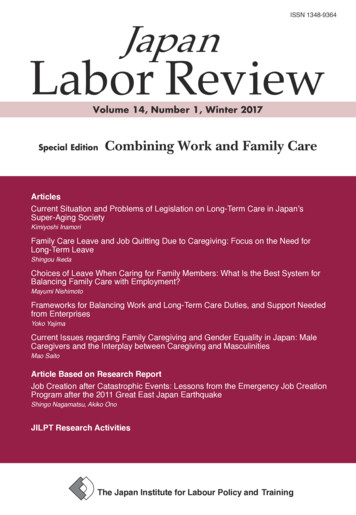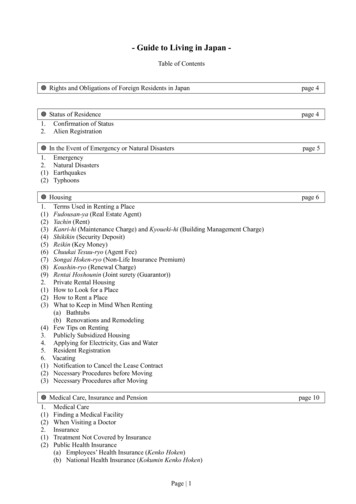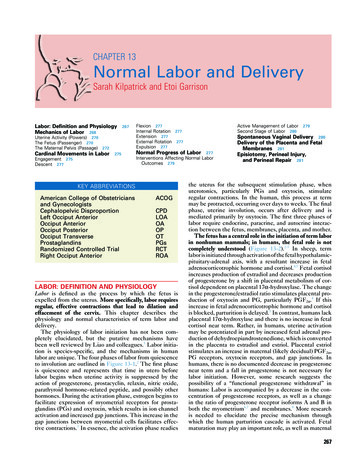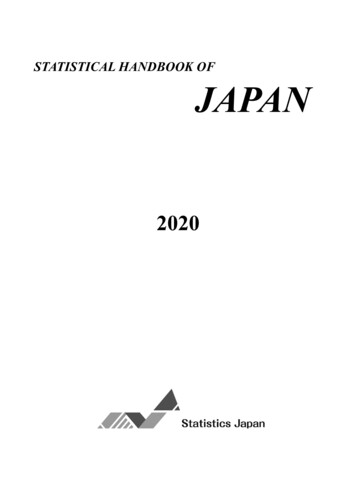
Transcription
JapanISSN 1348-9364Labor ReviewVolume 14, Number 1, Winter 2017Special EditionCombining Work and Family CareArticlesCurrent Situation and Problems of Legislation on Long-Term Care in Japan’sSuper-Aging SocietyKimiyoshi InamoriFamily Care Leave and Job Quitting Due to Caregiving: Focus on the Need forLong-Term LeaveShingou IkedaChoices of Leave When Caring for Family Members: What Is the Best System forBalancing Family Care with Employment?Mayumi NishimotoFrameworks for Balancing Work and Long-Term Care Duties, and Support Neededfrom EnterprisesYoko YajimaCurrent Issues regarding Family Caregiving and Gender Equality in Japan: MaleCaregivers and the Interplay between Caregiving and MasculinitiesMao SaitoArticle Based on Research ReportJob Creation after Catastrophic Events: Lessons from the Emergency Job CreationProgram after the 2011 Great East Japan EarthquakeShingo Nagamatsu, Akiko OnoJILPT Research ActivitiesThe Japan Institute for Labour Policy and Training
EDITOR-IN-CHIEFKazuo Sugeno, The Japan Institute for Labour Policy and TrainingEDITORIAL BOARDTamayu Fukamachi, The Japan Institute for Labour Policy and TrainingHiromi Hara, Japan Women’s UniversityYukie Hori, The Japan Institute for Labour Policy and TrainingShingou Ikeda, The Japan Institute for Labour Policy and TrainingMinako Konno, Tokyo Woman’s Christian UniversityYuichiro Mizumachi, Tokyo UniversityHiroshi Ono, Hitotsubashi UniversityTadashi Sakai, Hosei UniversityHiromi Sakazume, Hosei UniversityMasaru Sasaki, Osaka UniversityTomoyuki Shimanuki, Hitotsubashi UniversityHisashi Takeuchi, Waseda UniversityMitsuru Yamashita, Meiji UniversityThe Japan Labor Review is published quarterly in Spring (April), Summer (July), Autumn(October), and Winter (January) by the Japan Institute for Labour Policy and Training.EDITORIAL OFFICEThe Japan Institute for Labour Policy and TrainingResearch and Information Service Department8-23, Kamishakujii 4-chome, Nerima-ku, Tokyo 177-8502, JapanTEL: 81-3-5903-6274 FAX: 81-3-3594-1113Homepage: http://www.jil.go.jp/english/JLR/index.htmPrinted in Japan 2017 by the Japan Institute for Labour Policy and TrainingAll rights reserved.
Japan Labor Review to Start Life AnewReaders may like to know that our Japan Labor Review, published as an English-language quarterly on Japanese labor topics since January 2004, is to start life in acompletely new guise after this issue. May we take this opportunity to express our sincerethanks for your interest in Japan Labor Review until now.As a successor to Japan Labor Review, the Japan Institute for Labour Policy andTraining (JILPT) plans to publish a new English-language journal from 2017 (title, publication date and frequency to be decided). The new publication will maintain the basic principles of Japan Labor Review and will continue to present research papers, but will also provide the latest information and data on labor in Japan. It will serve as a medium for introducing hot topics in the Japanese labor field to a global audience in English, aimed at abroad-ranging readership that will include not only researchers but also people working inindustry, labor relations, governments and the media.We hope the new publication will enjoy the same patronage and support as its predecessor.Kazuo SugenoEditor-in-Chief, Japan Labor ReviewThe Japan Institute for Labour Policy and Training (JILPT)
Japan Labor ReviewVolume 14, Number 1Winter 2017CONTENTSCombining Work and Family CareArticles8Current Situation and Problems of Legislation on Long-Term Care in Japan’sSuper-Aging SocietyKimiyoshi Inamori25Family Care Leave and Job Quitting Due to Caregiving: Focus on the Need forLong-Term LeaveShingou Ikeda45Choices of Leave When Caring for Family Members: What Is the Best Systemfor Balancing Family Care with Employment?Mayumi Nishimoto68Frameworks for Balancing Work and Long-Term Care Duties, and Support Neededfrom EnterprisesYoko Yajima92Current Issues regarding Family Caregiving and Gender Equality in Japan:Male Caregivers and the Interplay between Caregiving and MasculinitiesMao SaitoArticle Based on Research Report112Job Creation after Catastrophic Events: Lessons from the Emergency Job CreationProgram after the 2011 Great East Japan EarthquakeShingo Nagamatsu, Akiko Ono132JILPT Research Activities
IntroductionCombining Work and Family CareAlthough the various research that has addressed the difficulties of balancing workand family life over the years has generally focused on issues related to raising children,increasing attention is being given to the task of caring for older people as an importantfamily responsibility as developed countries grapple with declining birthrates and agingpopulations. Among such countries, Japan is experiencing population aging at a particularlyrapid pace. Japan’s rate of population aging—namely, the percentage of people aged 65 orover among the total population—is currently the highest in the world, at over 25%. In thatsense, Japan is at the “forefront” of super-aging society. In the past, the Japanese government has looked to other countries such as the US and European nations as guides in formulating its policies, but in the field of policies related to older people, Japan may be facingissues that are yet to arise in other countries. This edition was compiled on the basis of theconcept that a publication of articles which grasp the development of such issues has thepotential to be a valuable source of information for researchers and policymakers in othercountries.The first article in this edition, “Current Situation and Problems of Legislation onLong-Term Care in Japan’s Super-Aging Society” by Kimiyoshi Inamori, investigates issues concerning policies to support caregiving for older people in Japan from the perspective of both the long-term care insurance system and the system of caregiver leave. Whilethe long-term care insurance system, which was first implemented in 2000, may try to provide sufficient benefits for older people who require long-term care, this system alone doesnot in fact necessarily always meet all of their care needs. Family caregiving is thereforerequired to complement long-term care insurance services. As the system of caregiver leaveestablished in the Child Care and Family Care Leave Act was created to allow people withfamily members requiring care to take time to prepare and arrange a system for that care tobe provided, income guarantees for workers on caregiver leave are provided in the form ofcaregiver leave benefits from the employment insurance system. However, noting that thepercentage of workers who actually take caregiver leave is extremely low, Inamori suggeststhat to assist workers in balancing work with family care it is more important to developschemes related to ways of working, such as short working hour systems or limits on overtime work. The issues raised in this article such as the need to increase the take up rate ofcaregiver leave and develop the system through measures for reduced working hours andlimitations on overtime work, are key points that have been addressed in the amendments tothe Child Care and Family Care Leave Act that will take effect in 2017. The revised actmakes caregiver leave easier to use by allowing caregivers to take the 93 days of leave inthree segments. It has also increased the minimum period during which employers areobliged to provide measures such as short working hours and other such schemes for re-
ducing working hours, etc. (also including flextime, pushing the time of starting or finishingwork forward or backward, and subsidizing the costs of long-term care), which allow caregivers to balance daily caregiving responsibilities with work, from the current 93 days tothree years. The Act also guarantees workers the right to restrictions on overtime workinghours until the end of caregiving.In “Family Care Leave and Job Quitting Due to Caregiving: Focus on the Need forLong-Term Leave,” I investigate the potential effects of these amendments to the ChildCare and Family Care Leave Act, as well as identifying new issues that require further examination. Based on the results of analysis of data on workers who are employed whencaregiving begins, the article reveals that (i) the greater the need to take caregiver leave, theless likely working caregivers are to remain continuously employed at the same enterprisefrom the beginning to the end of the caregiving period, but the need for caregiver leave canbe alleviated through the use of long-term care services, (ii) regardless of the degree of needto take caregiver leave, workers who work six hours or less per day are more likely to remain continuously employed at the same enterprise than those who work over eight hours aday, and (iii) those who care for their own parents have a greater need for caregiver leavethan those who care for the parents of a spouse, but regardless of the necessity for caregiverleave, among workers who provide care alone without assistance from their families, andworkers who care for relatives with severe dementia, there is a low likelihood of continuousemployment at the same enterprise. In other words, it can be said that a factor behind thelow numbers of people taking caregiver leave is the increase in the use of services offeredthrough long-term care insurance. However, social changes such as the increase in peoplecaring for their own biological parents and the rise in people who care for relatives alonewithout other family members to assist them suggest the possibility that in the future therewill continue to be an increase in the number of people leaving their employment due tocaregiving responsibilities. The analysis results indicate that in order to curb this increase,in addition to the caregiver leave system, it is also important to develop systems such asshort working hours and limitations on overtime hours. In this sense, the recent amendmentsto the Child Care and Family Care Leave Act are suited to addressing the current circumstances under which people leave employment to provide care. At the same time, as thecurrent framework was developed with the necessity for physical care that arises in the caseof cerebrovascular diseases and other such conditions in mind, it may not cover socialmeasures to support care for dementia, and this article also highlights the importance ofsuch measures as an issue that will require more extensive consideration in the future.Since the amendments that took effect in 2010, the Child Care and Family CareLeave Act has prescribed the obligation of enterprises to provide not only long-term caregiver leave but also “time off for caregivers” that can be taken in one-day units, and withthe introduction of the 2017 amendments caregivers will be able to take this time off inhalf-day units. Mayumi Nishimoto’s “Choices of Leave When Caring for Family Members:What Is the Best System for Balancing Family Care with Employment?” investigates the
necessity of not only leave that can be taken on a long-term basis, but also a flexibletime-off system like time off for caregivers. The results of the analysis reveal the followingfive points. Firstly, when the main caregiver ratio is higher, the likelihood of taking caregiver leave increases, and absenteeism is particularly likely. Secondly, leave is more likelyto be taken when the spouse works longer hours, especially when the spouse’s employmentformat precludes the control of those working hours. The likelihood of absenteeism is alsohigher if the spouse is a regular employee, and the likelihood of taking annual leave increases more or less significantly when the spouse is a regular employee or non-regular employee, or when there is no spouse. Thirdly, the likelihood that leave will be taken rises incases where the person requiring care is admitted to a general hospital or geriatric hospitaland in such cases caregiver leave and annual leave are particularly likely to be taken.Fourthly, absenteeism is more likely to occur when the caregiver has a lower annual income.Fifthly, absenteeism is also more prone to occur if the person is not a regular employee. Inother words, this indicates that depending on the environment of family caregiving, there isalso a demand not only for caregiving leave that can be taken on a long-term basis, but alsotime off that caregivers can take in single-day units.As is also indicated in the aforementioned articles, balancing work and caregiving isshaped by various environmental factors, such as social services and support from enterprises, as well as the factors highlighted by Nishimoto in relation to family environment. In“Frameworks for Balancing Work and Long-Term Care Duties, and Support Needed fromEnterprises,” Yoko Yajima focusses on the correlations between these various fields, pursuing quantitative analysis based on the hypothesis that the quality of the balance of workand care (“subjective sense that balance is achieved, and preservation of a feeling that workis rewarding”) differs depending on the frameworks and circumstances surrounding thebalance of work and care. In doing so she looks at these “frameworks and circumstancessurrounding the balance of work and care” from the five perspectives of attributes of thecaregiver, attributes of the care recipient, the relationship between these two people and therole the caregiver plays, the long-term care framework (including the use of long-term careservices, and cooperation from other family members), and the caregiver’s work style orformat (flexible work schedules and utilization of leave, etc.). The results of this analysisreveal that while caring for an elderly relative appears at first glance to place caregivers incircumstances that are more complex and diverse than those faced when raising children, iffactors such as the attributes of the care recipient, the relationship between the caregiver andcare recipient, and the long-term care framework are controlled, the types of support thatemployees seek from enterprises with regard to working styles and formats entail “curtailing excessively long working hours,” “creating an environment in which time off can betaken flexibly and support programs can be utilized with ease,” and “supervisors’ consideration for employees’ circumstances,” and there is hardly any difference between theseforms of support and the type of work environment required for employees raising childrento achieve work-life balance. However, given that if the care “framework” required for bal-
ancing work and long-term care duties is not in place, support related to work style andformat from enterprises will not function effectively, Yajima highlights that it is thereforeimportant that enterprises do not merely offer such support in terms of work styles and formats, but also encourage caregivers, who often try to handle duties directly by themselves,to focus on the “management of care services and division of duties,” that is, usinglong-term care services and other such support effectively and dividing duties among familymembers.The final article in this journal, “Current Issues regarding Family Caregiving andGender Equality in Japan: Male Caregivers and the Interplay between Caregiving and Masculinities” by Mao Saito, examines the problems faced by family caregivers in Japan fromthe perspective of gender. More specifically, Saito focuses on the increasing numbers ofmale caregivers in Japan, and investigates what significance the increase in male caregiversmay have for the achievement of gender equality in family caregiving, in light of the actualconditions of caregiving by male caregivers. Contemporary family caregiving is inseparablefrom the gender relationship between men as the breadwinners and women as the caregivers.At the same time, in Japan as in other countries, changes in family structures are leading toa growing number of situations in which men must take on caregiving roles. As men take oncaregiving roles, they are forced to confront their own masculinities, and by looking at thedifficulties faced by male caregivers, this article demonstrates that care and masculinitiesare not simply conflicting aspects of men’s identities.In discourse on “welfare regimes,” Japan is considered to be a conservative regime inwhich the family takes the key role in providing care. However, as family sizes declinealong with decreases in birth rates, it is becoming difficult to rely on families to providecare, and efforts have been made to supplement family care by socializing caregivingthrough the development of public long-term care services and company-based support forbalancing work and caregiving. Countries with social democratic regimes in which the government typically provides substantial policies for supporting elderly people and liberalregimes characterized by small government models may find that the onset of super-agingsociety necessitates some kinds of changes to their frameworks. We hope that this editionprovides useful insights to readers who are aware of such issues.Shingou IkedaThe Japan Institute for Labour Policy and Training
Current Situation and Problems of Legislation on Long-Term Care inJapan’s Super-Aging SocietyKimiyoshi InamoriKyoto UniversityThe long-term care insurance system, introduced in 2000, has promoted thesocialization of long-term care and helped to reduce the burden on familieswith elderly relatives who need long-term care. But while the purpose of thelong-term care insurance system is to provide a necessary and sufficient levelof benefits for elderly persons in need of long-term care, the system alone doesnot necessarily meet all of their care needs. As a result, family care or servicesother than long-term care insurance are required to complement long-term careinsurance services. The system of care leave based on the Child Care andFamily Care Leave Act was established as a preparatory period with the aim ofbuilding a system for long-term care of family members in need of such care;income guarantees during the care leave period are provided in the form ofcare leave benefits from the employment insurance system. However, the rateof care leave actually taken remains at an extremely low level, despite progress by businesses in establishing related regulations. What is more importantis to create schemes for working formats, such as short working hour systemsor limits on overtime work, to assist workers in balancing everyday and continuous employment with family care.I.IntroductionWhat kind of long-term care has been sought by the Japanese legal system until now?Amid the ongoing trends toward birth rate decline and population aging, various initiativesare currently being promoted in the field of guaranteed elderly care, including promotion ofthe integrated community care system. These have their sights set on the year 2025, whenthe baby boom generation will pass the age of 75. This paper will examine developments todate in various legislation on long-term care for the elderly, and study existing problems.The principal focus will be on the Long-Term Care Insurance Act, which is mainly responsible for guaranteeing public care services for elderly persons in need of long-term care, theChild Care and Family Care Leave Act,1 which helps workers who have elderly relatives ina care-requiring condition to balance their employment with family care, and the Employment Insurance Act, which is responsible for income guarantees during periods of careleave.1The full name of this law, at present, is the “Act on the Welfare of Workers Who Take Care ofChildren or Other Family Members Including Child Care and Family Care Leave.”8
Legislation on Long-Term Care in Japan’s Super-Aging SocietyII. The Basic Structure of Existing Legislation on Guaranteed Care1. The System of Long-Term Care InsuranceSince the Long-Term Care Insurance Act came into effect in April 2000, long-termcare insurance has been central to the system for guaranteeing public care services. Personsinsured under long-term care insurance are those who are domiciled in the catchment areaof a municipality and are 65 years of age or more (“primary insured persons”) and thoseinsured by public medical insurance who are domiciled in a municipality and are betweenthe ages of 40 and 64 (“secondary insured persons”). The system is mainly funded by contributions from insured persons and their employers. When an insured person enters a condition of need for long-term care, etc., is certified as such, and receives long-term care insurance services from a designated operator or similar, based on a service utilization agreement, 90% of the service cost is paid as insurance benefits.2 The Long-Term Care InsuranceAct states that necessary insurance benefits shall be provided for conditions of need forlong-term care, etc., of the insured person (Article 2 para. 1 of the Act), and that “With regard to the contents and level of insurance benefits, consideration must be given so that theinsured is able to live an independent daily life according to that person’s own abilities inhis or her home as much as possible, even if said insured person enters a condition of needfor long-term care” (Article 2 para. 4). In reality, however, for those living at home, a maximum payment commensurate with the need for long-term care has been set fornon-residential in-home services and community-based services that are provided (in combination) based on an in-home service plan (“care plan”) (Article 43 para. 1).3 This meansthat there is an upper limit to the volume of long-term care insurance services that can bereceived (though full services can be received by paying the whole amount in excess of themaximum limit ( “combined long-term care”)). For those admitted to a facility, the minimum required care services are provided by the intensive care home for the elderly or otheradmitting facility by establishing remuneration for comprehensive long-term care, but manypeople are waiting to be admitted owing to a supply shortage. Thus, Japan’s long-term careinsurance does not necessarily meet all the care needs of each person in need of such care.4280% in the case of higher earners. In reality, users pay their own contribution of 10% or 20% tothe service provider, and the remaining 90% or 80% is paid by the insurer to the service provider asremuneration for long-term care. Meanwhile, the cost of creating care plans is covered 100% by benefits, so that the user pays nothing.3Besides this, if a specific service is lacking, municipalities may stipulate a base amount of maximum payment for the categories of allowances at their own discretion, but there are few examples ofthis in practice.4When calculating long-term care insurance premiums, the volume of long-term care insuranceservices needed in each three-year period (a fiscal unit) is estimated for each level of long-term careneed, and insurance premiums are set by calculating back from the amount needed for the corresponding benefits. In that sense, compared to the German long-term care insurance system, wherelevels of insurance benefits are set within a range that can be covered by long-term care insurancefinances, Japan’s long-term care insurance has been described as a “necessary and sufficient benefit9
Japan Labor Review, vol. 14, no. 1, Winter 20172. Care Service Guarantee Systems Other than Long-Term Care InsuranceThere are various publicly funded systems guaranteeing care services other thanlong-term care insurance, which are used to complement the long-term care insurance system. Specifically, these are welfare safeguard measures under the Act on Social Welfare forthe Elderly, independence support benefits based on the Act on Comprehensive Support forPersons with Disablities (ACSPD),5 and care assistance based on the Public Assistance Act.Since the Long-Term Care Insurance Act came into effect, welfare safeguardmeasures under the Act on Social Welfare for the Elderly (ASWE) have mainly been applied when it is difficult to use long-term care insurance, such as in emergencies, or whenan adult guardian needs to be secured in order to enter an agreement for the use of services(ASWE Articles 10–4, 11).As independence support benefits based on the Act on Comprehensive Support forPersons with Disabilities, persons with disabilities may receive payments of care benefitsfor in-home care and other disabled welfare services (ACSPD Article 28 para. 1 onwards).Long-term care insurance takes precedence when those services are also being received(Article 7), meaning that independence support benefits serve to supplement or augmentlong-term care insurance.6For welfare recipients, because those aged 65 and over contribute to long-term careinsurance as primary insured persons, the precedence of long-term care insurance meansthat amounts equivalent to long-term care insurance premiums are paid as additionallong-term care insurance premiums for livelihood assistance, and a user contribution is paidtype” (Masanobu Masuda, “Nihon to doitsu no kaigo hoken-kan no soui [Differences between Japanese and German long-term care insurance],” Shukan Shakai Hosho, no. 2798 (2014), p.32). Nevertheless, certification of the level of long-term care need is focused solely on the individual’s ability toperform daily living activity, irrespective of the care environment in which each person in acare-requiring condition is placed. As such, the required volume of long-term care is calculated fromthe hours of care, and therefore does not necessarily meet the actual care needs of each individual in acare-requiring condition. Unlike medical services, the volume of services required for long-term careis difficult to quantify objectively in the first place, and therefore, in the long-term care insurancesystem, combined long-term care is permitted as it takes the form of monetary benefits. In that sense,Japan’s long-term care insurance system is also “partial insurance” (Shuzo Tsutsumi, Kaigo hoken noimiron: Seido no honshitsu kara kaigo hoken no korekara wo kangaeru [Semantics of long-term careinsurance: Considering the future of long-term care insurance based on the essence of the system],(Tokyo: Chuo Hoki Shuppan, 2010), p.48).5The full name is “the Act to Comprehensively Support the Daily Life and Social Life of Personswith Disabilities.”6“On the application relationship between independence support benefits based on the Act toComprehensively Support the Daily Life and Social Life of Persons with Disabilities and thelong-term care insurance system” (03/28/07 Shōkihatsu No. 0328002, Shōshōhatsu No. 0328002).However, long-term care insurance services are not uniformly given precedence, but rather an individual judgment is to be made as to whether long-term care insurance services corresponding to disabled welfare services are to be received (Shogaisha Fukushi Kenkyukai, ed., Chikujo kaisetsu shogaisha sogo shien ho [Article-by-article commentary on the Act on Comprehensive Support for Personswith Disabilities], (Tokyo: Chuo Hoki, 2013), p.79).10
Legislation on Long-Term Care in Japan’s Super-Aging Societywhen using long-term care insurance services (10% in principle) as care assistance, respectively. On the other hand, welfare recipients aged under 65 are exempt from the applicationof national health insurance, and therefore do not contribute to long-term care insurance. Asa result, the necessary care services are provided as care assistance for welfare support.As to welfare safeguard measures and the payment of care benefits, one may discerna degree of administrative discretion on decisions for or against, and on the details.As shown above, the system of public guaranteed care services does not necessarilyalways meet the care needs of each individual in need of long-term care, etc.; in some cases,it needs to be supplemented by care provided by the family itself or by private care servicesother than long-term care insurance.3. System Based on the Child Care and Family Care Leave ActChanges in family composition, in the form of the progressive nuclearization of thefamily and women’s advancement into the labor market, combined with other factors including the prolongation of care accompanying increased longevity due to advances inmedicine, have had a major impact on the nature of family care. Elderly people living aloneor in husband-and-wife households have increased, and a growing problem is to ascertainwhich family member should be responsible for long-term care. While people in employment are increasingly taking care of family members, the Child Care and Family CareLeave Act (CCFCLA) specifies several ways of facilitating a balance between employmentand care.Firstly, there is the system of taking family care leave to care for a subject familymember in a care-requiring condition (CCFCLA Article 2 para. 2). Workers (except daylaborers) may take care leave by submitting a request to their employer, specifying (1) thatthe subject family member pertaining to the care leave request is in a care-requiring condition, and (2) the first and last days of the care leave period (Article 11 paras. 1 and 3).However, employees on fixed-period contracts may only do so when they have been employed by the same employer continuously for at least one year at the time of the request,and when it is not certain that the labor contract will have expired within six months afterthe 93 days allocated for care leave. Workers with an employment period of less than oneyear, those whose employment relationship will end within 93 days, and those whose contractual working days are two or fewer days per week may be made ineligible by a labor-management agreement.A “care-requiring condition” is defined as a condition requiring constant care for aperiod of two weeks or more due to injury, sickness, or physical or mental disability (Article2 (iii), Enf. Regs. Article 1). The standards for judging “a condition requ
Program after the 2011 Great East Japan Earthquake Shingo Nagamatsu, Akiko Ono . Waseda University Mitsuru Yamashita, Meiji University The Japan Labor Review is published quarterly in Spring (April), Summer (July), Autumn (October), and Winter (January) by the Japan Institute for Labour Policy and Training. .










